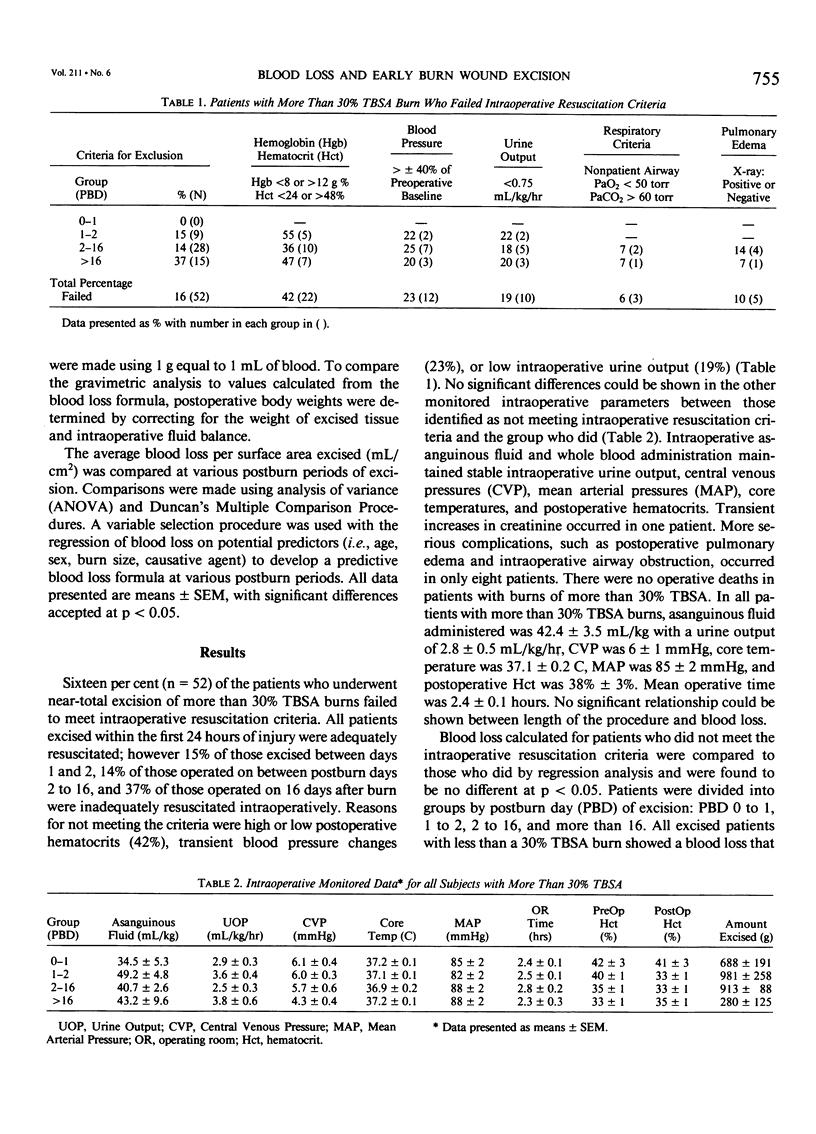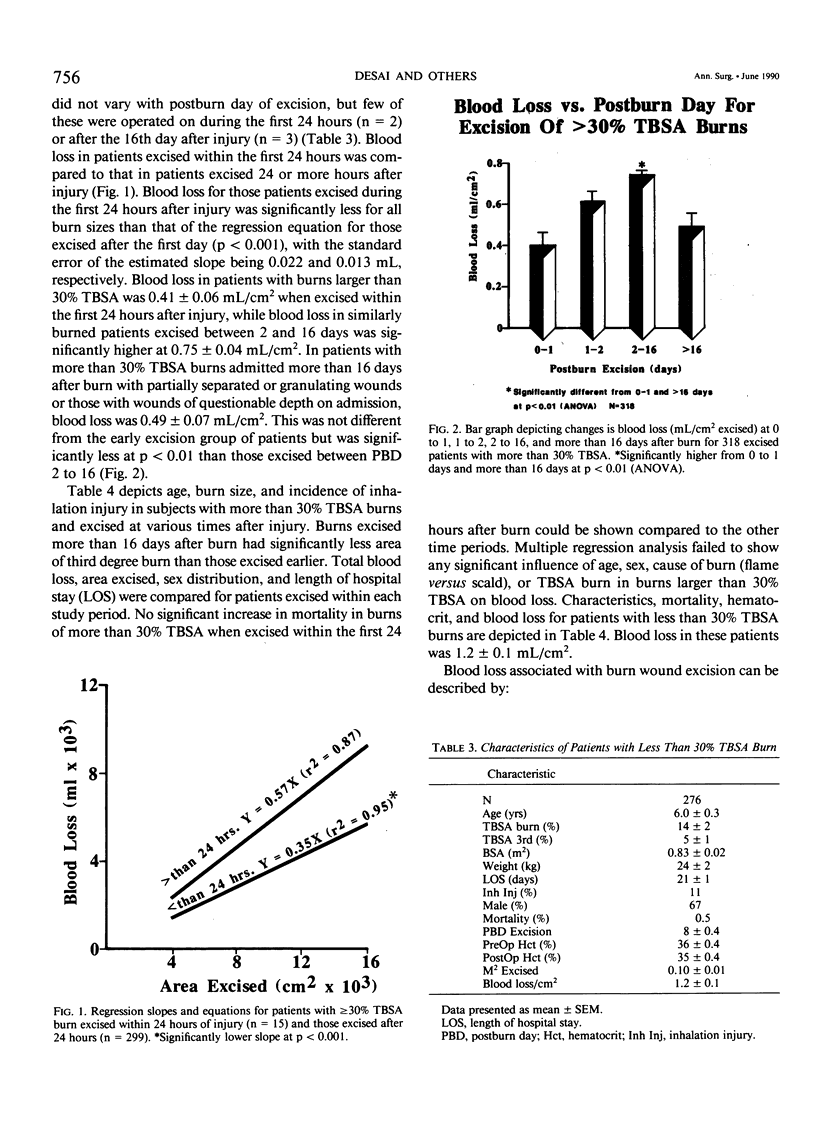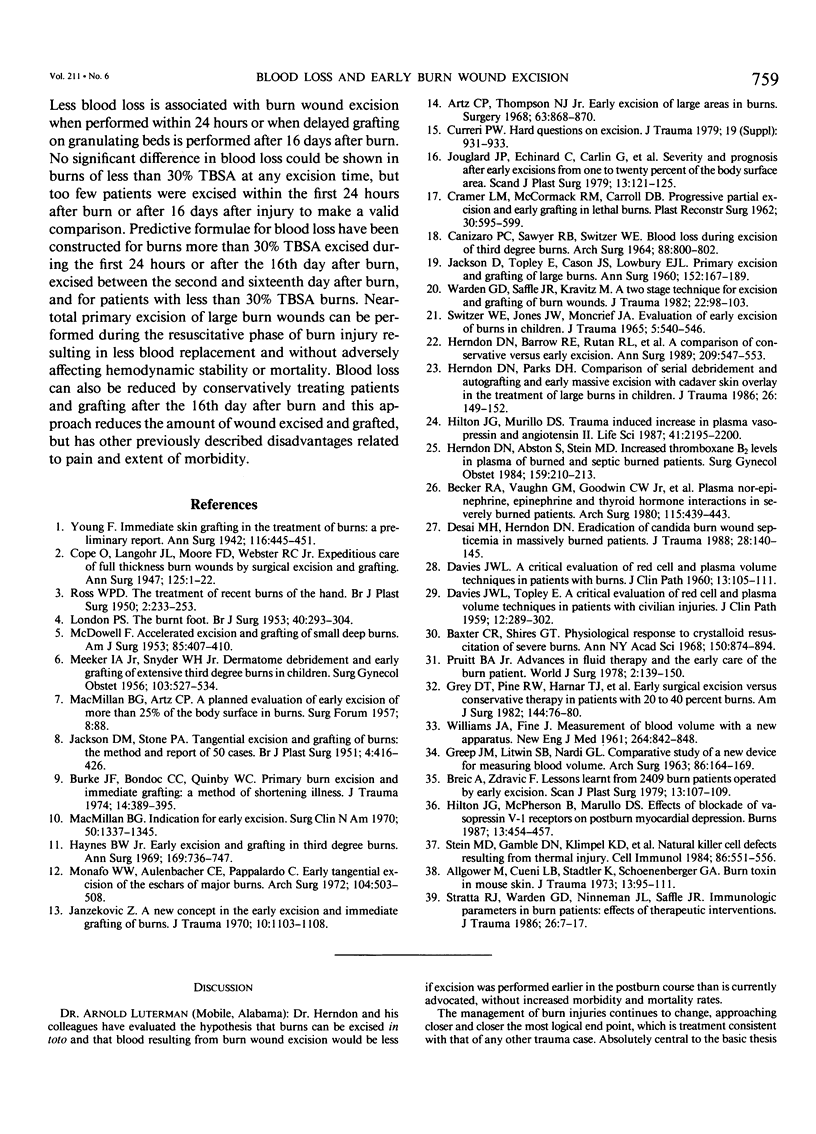Abstract
The hypothesis that near-total early excision of large burns in children can be performed safely with a reduction in blood loss was tested. Of 1662 acutely burned patients admitted to this institution between 1982 and 1989, 594 underwent near-total excision of cutaneous flame or scald burn injuries in a single procedure. Operations took less than 3 hours and there were no operative deaths. Blood losses in burns of more than 30% total body surface area (TBSA) were significantly less at 0.40 +/- 0.06 mL/cm2 and 0.49 +/- 0.49 mL/cm2 excised when surgery was performed within the first 24 hours or after the 16th day after burn, respectively, when compared to 0.75 +/- 0.02 mL/cm2 for those excised between 2 and 16 days after burn (p less than 0.05). Blood loss for burns of less than 30% TBSA was of 1.19 +/- 0.13 mL/cm2. Early excision did not increase mortality rate when compared to later excision times. We suggest that near-total excision of large burns within the first 24 hours reduces blood requirements and morbidity without adversely altering hemodynamic stability or increasing mortality risks.
Full text
PDF






Images in this article
Selected References
These references are in PubMed. This may not be the complete list of references from this article.
- Allgöwer M., Cueni L. B., Städtler K., Schoenenberger G. A. Burn toxin in mouse skin. J Trauma. 1973 Feb;13(2):95–111. doi: 10.1097/00005373-197302000-00002. [DOI] [PubMed] [Google Scholar]
- Artz C. P., Thompson N. J., Jr Early excision of large areas in burns. Surgery. 1968 May;63(5):868–870. [PubMed] [Google Scholar]
- Baxter C. R., Shires T. Physiological response to crystalloid resuscitation of severe burns. Ann N Y Acad Sci. 1968 Aug 14;150(3):874–894. doi: 10.1111/j.1749-6632.1968.tb14738.x. [DOI] [PubMed] [Google Scholar]
- Becker R. A., Vaughan G. M., Goodwin C. W., Jr, Ziegler M. G., Harrison T. S., Mason A. D., Jr, Pruitt B. A. Plasma norepinephrine, epinephrine, and thyroid hormone interactions in severely burned patients. Arch Surg. 1980 Apr;115(4):439–443. doi: 10.1001/archsurg.1980.01380040067012. [DOI] [PubMed] [Google Scholar]
- Brcić A., Zdravic F. Lessons learnt from 2,409 burn patients operated by early excision. Scand J Plast Reconstr Surg. 1979;13(1):107–109. doi: 10.3109/02844317909013034. [DOI] [PubMed] [Google Scholar]
- Burke J. F., Bondoc C. C., Quinby W. C. Primary burn excision and immediate grafting: a method shortening illness. J Trauma. 1974 May;14(5):389–395. doi: 10.1097/00005373-197405000-00005. [DOI] [PubMed] [Google Scholar]
- CANIZARO P. C., SAWYER R. B., SWITZER W. E. BLOOD LOSS DURING EXCISION OF THIRD-DEGREE BURNS. Arch Surg. 1964 May;88:800–802. doi: 10.1001/archsurg.1964.01310230076015. [DOI] [PubMed] [Google Scholar]
- CRAMER L. M., McCORMACK R. M., CARROLL D. B. Progressive partial excision and early graftin in lethal burns. Plast Reconstr Surg Transplant Bull. 1962 Nov;30:595–599. doi: 10.1097/00006534-196211000-00007. [DOI] [PubMed] [Google Scholar]
- Cope O., Langohr J. L., Moore F. D., Webster R. C. Expeditious Care of Full-Thickness Burn Wounds by Surgical Excision and Grafting. Ann Surg. 1947 Jan;125(1):1–22. [PMC free article] [PubMed] [Google Scholar]
- Curreri P. W. Supportive therapy in burn care. Hard questions on excision. J Trauma. 1979 Nov;19(11 Suppl):931–933. [PubMed] [Google Scholar]
- DAVIES J. W. A critical evaluation of red cell and plasma volume techniques in patients with burns. J Clin Pathol. 1960 Mar;13:105–111. doi: 10.1136/jcp.13.2.105. [DOI] [PMC free article] [PubMed] [Google Scholar]
- DAVIES J. W., TOPLEY E. A critical evaluation of red cell and plasma volume techniques in patients with civilian injuries. J Clin Pathol. 1959 Jul;12:289–302. doi: 10.1136/jcp.12.4.289. [DOI] [PMC free article] [PubMed] [Google Scholar]
- Desai M. H., Herndon D. N. Eradication of Candida burn wound septicemia in massively burned patients. J Trauma. 1988 Feb;28(2):140–145. doi: 10.1097/00005373-198802000-00002. [DOI] [PubMed] [Google Scholar]
- GREEP J. M., LITWIN S. B., NARDI G. L. Comparative study of new device for measuring blood volume. Arch Surg. 1963 Jan;86:164–169. doi: 10.1001/archsurg.1963.01310070166022. [DOI] [PubMed] [Google Scholar]
- Gray D. T., Pine R. W., Harnar T. J., Marvin J. A., Engrav L. H., Heimbach D. M. Early surgical excision versus conventional therapy in patients with 20 to 40 percent burns. A comparative study. Am J Surg. 1982 Jul;144(1):76–80. doi: 10.1016/0002-9610(82)90605-5. [DOI] [PubMed] [Google Scholar]
- Haynes B. W., Jr Early excision and grafting in third degree burns. Ann Surg. 1969 May;169(5):736–747. doi: 10.1097/00000658-196905000-00011. [DOI] [PMC free article] [PubMed] [Google Scholar]
- Herndon D. N., Abston S., Stein M. D. Increased thromboxane B2 levels in the plasma of burned and septic burned patients. Surg Gynecol Obstet. 1984 Sep;159(3):210–213. [PubMed] [Google Scholar]
- Herndon D. N., Barrow R. E., Rutan R. L., Rutan T. C., Desai M. H., Abston S. A comparison of conservative versus early excision. Therapies in severely burned patients. Ann Surg. 1989 May;209(5):547–553. doi: 10.1097/00000658-198905000-00006. [DOI] [PMC free article] [PubMed] [Google Scholar]
- Herndon D. N., Parks D. H. Comparison of serial debridement and autografting and early massive excision with cadaver skin overlay in the treatment of large burns in children. J Trauma. 1986 Feb;26(2):149–152. doi: 10.1097/00005373-198602000-00009. [DOI] [PubMed] [Google Scholar]
- Hilton J. G., Marullo D. S. Trauma induced increases in plasma vasopressin and angiotensin II. Life Sci. 1987 Nov 9;41(19):2195–2200. doi: 10.1016/0024-3205(87)90515-7. [DOI] [PubMed] [Google Scholar]
- Hilton J. G., McPherson M. B., Marullo D. S. Effects of blockade of vasopressin V-1 receptors on post-burn myocardial depression. Burns Incl Therm Inj. 1987 Dec;13(6):454–457. doi: 10.1016/0305-4179(87)90222-1. [DOI] [PubMed] [Google Scholar]
- JACKSON D., TOPLEY E., CASON J. S., LOWBURY E. J. Primary excision and grafting of large burns. Ann Surg. 1960 Aug;152:167–189. doi: 10.1097/00000658-196008000-00001. [DOI] [PMC free article] [PubMed] [Google Scholar]
- Janzekovic Z. A new concept in the early excision and immediate grafting of burns. J Trauma. 1970 Dec;10(12):1103–1108. [PubMed] [Google Scholar]
- Jouglard J. P., Echinard C., Carlin G., Manelli J. C., Palayret D. Severity and prognosis after early excisions from one to twenty percent of the body surface area. Scand J Plast Reconstr Surg. 1979;13(1):121–125. doi: 10.3109/02844317909013038. [DOI] [PubMed] [Google Scholar]
- LONDON P. S. The burn foot. Br J Surg. 1953 Jan;40(162):293–304. doi: 10.1002/bjs.18004016202. [DOI] [PubMed] [Google Scholar]
- MACMILLAN B. G., ARTZ C. P. A planned evaluation of early excision of more than twenty-five per cent of the body surface in burns. Surg Forum. 1957;7:88–93. [PubMed] [Google Scholar]
- MCDOWELL F. Accelerated excision and grafting of small deep burns. Am J Surg. 1953 Mar;85(3):407–410. doi: 10.1016/0002-9610(53)90630-8. [DOI] [PubMed] [Google Scholar]
- MEEKER I. A., Jr, SNYDER W. H., Jr Dermatome débridement and early grafting of extensive third degree burns in children. Surg Gynecol Obstet. 1956 Nov;103(5):527–534. [PubMed] [Google Scholar]
- MacMillan B. G. Indications for early excision. Surg Clin North Am. 1970 Dec;50(6):1337–1345. doi: 10.1016/s0039-6109(16)39292-1. [DOI] [PubMed] [Google Scholar]
- Monafo W. W., Aulenbacher C. E., Pappalardo C. Early tangential excision of the eschars of major burns. Arch Surg. 1972 Apr;104(4):503–508. doi: 10.1001/archsurg.1972.04180040117020. [DOI] [PubMed] [Google Scholar]
- Pruitt B. A., Jr Advances in fluid therapy and the early care of the burn patient. World J Surg. 1978 Mar;2(2):139–150. doi: 10.1007/BF01553536. [DOI] [PubMed] [Google Scholar]
- ROSS W. P. D. The treatment of recent burns of the hand. Br J Plast Surg. 1950 Jan;2(4):233–253. [PubMed] [Google Scholar]
- SWITZER W. E., JONES J. W., MONCRIEF J. A. EVALUATION OF EARLY EXCISION OF BURNS IN CHILDREN. J Trauma. 1965 Jul;5:540–546. doi: 10.1097/00005373-196507000-00013. [DOI] [PubMed] [Google Scholar]
- Stein M. D., Gamble D. N., Klimpel K. D., Herndon D. N., Klimpel G. R. Natural killer cell defects resulting from thermal injury. Cell Immunol. 1984 Jul;86(2):551–556. doi: 10.1016/0008-8749(84)90412-x. [DOI] [PubMed] [Google Scholar]
- Stratta R. J., Warden G. D., Ninnemann J. L., Saffle J. R. Immunologic parameters in burned patients: effect of therapeutic interventions. J Trauma. 1986 Jan;26(1):7–17. doi: 10.1097/00005373-198601000-00002. [DOI] [PubMed] [Google Scholar]
- WILLIAMS J. A., FINE J. Measurement of blood volume with a new apparatus. N Engl J Med. 1961 Apr 27;264:842–848. doi: 10.1056/NEJM196104272641702. [DOI] [PubMed] [Google Scholar]
- Warden G. D., Saffle J. R., Kravitz M. A two-stage technique for excision and grafting of burn wounds. J Trauma. 1982 Feb;22(2):98–103. doi: 10.1097/00005373-198202000-00004. [DOI] [PubMed] [Google Scholar]
- Young F. IMMEDIATE SKIN GRAFTING IN THE TREATMENT OF BURNS: A PRELIMINARY REPORT. Ann Surg. 1942 Sep;116(3):445–451. doi: 10.1097/00000658-194209000-00017. [DOI] [PMC free article] [PubMed] [Google Scholar]



